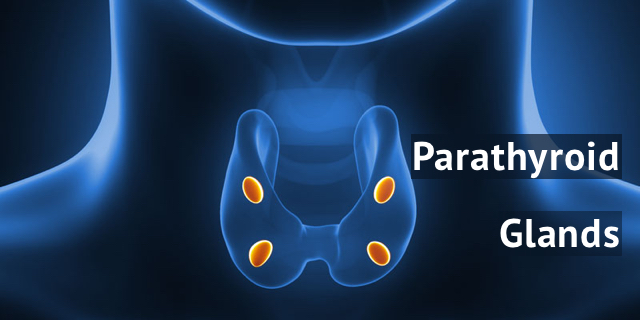In a continuation of posts on the endocrine system, we introduce four tiny glands (the size of a grain of rice) that perform a huge job. The parathyroid glands are in charge of keeping the calcium levels in your body in balance.
Parathyroid Glands Location
![]() For most people, the parathyroid glands are located behind the thyroid gland (See: What does the thyroid gland do?). But not everyone’s parathyroids are found there. During prenatal development, the parathyroid glands usually migrate from the head to the neck, but in some babies they move farther down and are found in the chest. They can also be found near the jawbone, inside the thyroid gland or even next to the carotid artery.
For most people, the parathyroid glands are located behind the thyroid gland (See: What does the thyroid gland do?). But not everyone’s parathyroids are found there. During prenatal development, the parathyroid glands usually migrate from the head to the neck, but in some babies they move farther down and are found in the chest. They can also be found near the jawbone, inside the thyroid gland or even next to the carotid artery.
Parathyroid Glands Function
Although their name has “thyroid” in it, they are separate in their functions from the thyroid gland.
![]() Parathyroid glands perform a balancing act with the electrolytes, calcium and phosphorus (phosphates) keeping tight control of these chemicals in the blood. Calcium is involved in blood
Parathyroid glands perform a balancing act with the electrolytes, calcium and phosphorus (phosphates) keeping tight control of these chemicals in the blood. Calcium is involved in blood  clotting, normal heart rhythm, muscle contraction, formation of bones and teeth, the actions of enzymes in the gastrointestinal system, transport of nutrients into cells, and energy production. It is also essential for transmitting electrical impulses along nerves. It is an all-purpose electrolyte. Phosphates are involved in energy production in the cell as well as being essential to bone and teeth formation.
clotting, normal heart rhythm, muscle contraction, formation of bones and teeth, the actions of enzymes in the gastrointestinal system, transport of nutrients into cells, and energy production. It is also essential for transmitting electrical impulses along nerves. It is an all-purpose electrolyte. Phosphates are involved in energy production in the cell as well as being essential to bone and teeth formation.
![]() There are receptors on the cells in the parathyroid that monitor calcium in the blood. Parathyroids produce PTH or parathyroid hormone.
There are receptors on the cells in the parathyroid that monitor calcium in the blood. Parathyroids produce PTH or parathyroid hormone.
If there is not need for calcium in the body, the parathyroid does not release PTH. If there is a need, PTH is released. PTH breaks down bone, where most of the body’s calcium is stored, and this raises the amount of calcium in the blood. PTH also increases the ability of the cells of your body to absorb calcium from food. Finally, PTH acts on the kidneys, making them more likely to hold onto calcium, instead of releasing it into urine.
When something goes wrong
![]() Primary hyperparathyroidism occurs when one or more of the parathyroid glands enlarge (hyperplasia) or when they have developed a benign (not cancerous) tumor. In extremely rare occasions (1 in 2 million), a parathyroid gland will develop cancer.
Primary hyperparathyroidism occurs when one or more of the parathyroid glands enlarge (hyperplasia) or when they have developed a benign (not cancerous) tumor. In extremely rare occasions (1 in 2 million), a parathyroid gland will develop cancer.
Hyperparathyroidism causes the parathyroid glands to overproduce PTH, resulting in high levels of calcium and low levels of phosphates in the blood.
The symptoms of hyperparathyroidism are headaches, fatigue, depression, memory loss and poor concentration. Additional symptoms include kidney stones (due to too much calcium in the blood), osteoporosis (loss of calcium in the bones), hypertension and cardiac arrhythmias.
The longer hyperparathyroidism occurs, the more damage it does to the body. The treatment for hyperthyroidism is surgery to remove the effected parathyroid gland.
Secondary hyperparathyroidism means that something else, besides a tumor, is causing your parathyroids to produce too much PTH. If you have a severe calcium deficiency in your diet, have very low Vitamin D or chronic kidney failure, you can develop secondary hyperparathyroidism.
Hyperparathyroidism risk factors
![]() The average levels of PTH in the body are between 10 and 65 picograms per milliliter (pg/ml). Primary hyperparathyroidism is more likely to occur in older women. It is also more likely in people who have undergone ionizing radiation therapy (not radiation exposures that occur in day-to-day life or from routine X-rays). And people who have been treated with lithium for bipolar disorder are at greater risk for hyperparathyroidism.
The average levels of PTH in the body are between 10 and 65 picograms per milliliter (pg/ml). Primary hyperparathyroidism is more likely to occur in older women. It is also more likely in people who have undergone ionizing radiation therapy (not radiation exposures that occur in day-to-day life or from routine X-rays). And people who have been treated with lithium for bipolar disorder are at greater risk for hyperparathyroidism.
For other posts on the endocrine system, see What is Insulin? Appreciating the Remarkable Pancreas, 5 Things You Probably Didn’t Know About Your Adrenal Glands and What Does Your Thyroid Gland Do?






I have been diagnosed with hyperparathyroidism. I had hypothyroid
disease but though I had mentioned how tired I was and that my bones hurt, my physicians never ordered the blood test for PTH that would have diagnosed the problem earlier. In fact, They did not mention that I had 10 mm kidney stones in both kidneys for a year and a half.
During the last 10 years I have had 3 infected areas that acted like pimples but when I opened them, no puss came out and they were a lot more painful to open than a pimple. They were located on both sides of my clavicle and one at my sternum next to my left breast.
After I went to a urologist for the kidney stones, and an Endocrinologist, and had several scans with dye and other stuff as well as exrays, the surgeon mentioned it is unclear where the parathyroids are. I don’t feel I should have exploratory surgery until we are sure where the glands might be. I did tell my surgeon about the self surgery.
Would you please comment on how to proceed?
You should always consider getting a second opinion at a center of excellence if you are unsure of your diagnosis or recommended treatment. Best wishes, Kathleen
Like the previous commenter, I am also hypothyroid (Hashi’s) AND hyperparathyroid. Still waiting on localization scan (ultrasound and Sestamibi done by local clinic who rarely deal with this unsuccessful), and surgery after. Mine was found because of calcium tests in blood chem for another nasty issue. The headaches and bone pain are very, very real.